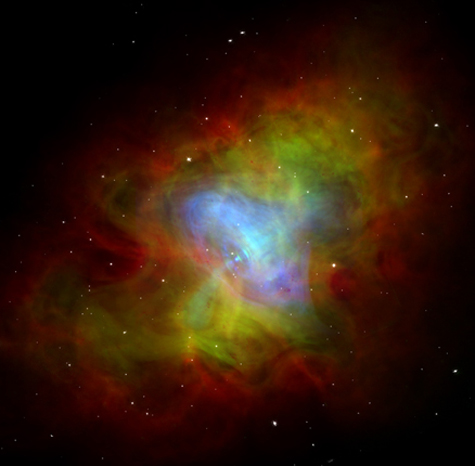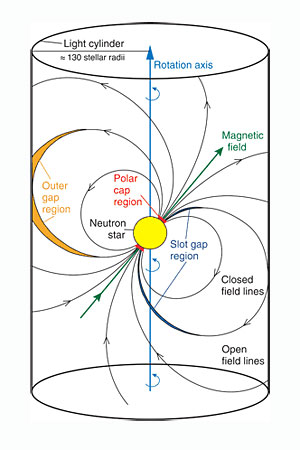
X-ray: NASA/CXC/ASU/J. Hester et al.; Optical: NASA/HST/ASU/J. Hester et al.; Radio: NRAO/AUI/NSF
Image of the Crab Nebula combines visible light (green) and radio waves (red) emitted by the remnants of a cataclysmic supernova explosion in the year 1054. and the x-ray nebula (blue) created inside the optical nebula by a pulsar (the collapsed core of the massive star destroyed in the explosion). The pulsar, which is the size of a small city, was discovered only in 1969. The optical data are from the Hubble Space Telescope, and the radio emission from the National Radio Astronomy Observatory, and the X-ray data from the Chandra Observatory.
An international collaboration of astrophysicists, including a group from the Department of Physics in Arts & Sciences at Washington University in St. Louis, has detected pulsed gamma rays from the neutron star at the heart of the Crab Nebula with energies far higher than the common theoretical models can explain.
The pulsed gamma rays had energies between 100 and 400 billion electronvolts (Gigaelectronvolts, or GeV), far higher than 25 GeV, the highest energy radiation from the neubla previously detected. A 400 GeV photon is 11 orders of magnitude – almost a trillion times – more energetic than a visible light photon.
The high-energy emission was detected by the VERITAS array of four 12-meter Cherenkov telescopes in Arizona that looks for the fleeting signatures of gamma-ray collisions with Earth’s atmosphere in the skies overhead. The research is published in the Oct. 7 issue of Science.
“We presented the results at a conference and the entire community was stunned,” says Henric Krawczynski, PhD, professor of physics at Washington University. The WUSTL group led by James H. Buckley, PhD, professor of physics, and Krawczynski is one of six founding members of the VERITAS consortium.
The Crab Nebula is the spectacular remains of a massive star that became a supernova in the year 1054 and was brilliant enough that its flaring was recorded by Chinese and Arab astronomers. The collapsed core of the defunct star, a pulsar discovered only in 1969, is only 30 kilometers in diameter but pumps out enormous amounts of energy, making the nebula 75,000 times brighter than the Sun. The dance of the high-energy particles spewed by the star and its strong magnetic field fill the inner nebula with phantasmagoric, ever-changing shapes like expanding rings made up flickering knots and turbulent high-speed jets.
Jets of particles stream out of the pulsar’s magnetic poles, producing powerful beams of light. Because the magnetic field and the star’s spin axis are not aligned, these beams sweep out a circle in space, crossing the line of sight from Earth at regular intervals, so that the emission appears to pulse.
“The pulsar in the center of the nebula had been seen in radio, optical, X-ray and soft gamma-ray wavelengths,” says Matthias Beilicke, PhD, research assistant professor of physics at Washington University. “But we didn’t think it was radiating pulsed emissions above 100 GeV. VERITAS can observe gamma-rays between100 GeV and 30 trillion electronvolts (Teraelectronvolts or TeV).
Scientists had looked at the higher energy range before but with instruments that had much lower sensitivities than VERITAS.
Beilicke, Buckley and Krawczynski are members of WUSTL’s McDonnell Center for the Space Sciences in Arts & Sciences.
Nepomuk Otte, PhD, a VERITAS scientist and a postdoctoral researcher at the University of California, Santa Cruz, advocated using the powerful gamma-ray observatory to look at the pulsar, even though the emission cut-off was thought to be much lower than the telescopes trigger energy.
The VERITAS team turned the telescope to the pulsar for 107 hours over a period of four years. To everyone’s surprise, they found a very high energy pulsed emission.
They can be absolutely certain the high-energy beam is coming from the pulsar because it has exactly the same period as the pulsed radio and X-ray emissions that have long been observed.
Models of pulsar emission worked out to explain these earlier observations can’t explain the VERITAS result without major adjustments.

MAGIC Collaboration
The VERITAS result doesn’t fit with standard models of pulsar emission. The pulsar is surrounded by a plasma-filled superconducting magnetosphere that rotates rigidly with the star except where there are open field lines. (The “light cylinder” marks the boundary where plasma rotates at the speed of light to stay with the pulsar.) Particles accelerated across “vacuum gaps” in the magnetosphere emit the electromagnetic radiation such as gamma rays. Still unresolved is the location of the gaps and the mechanism by which the radiation is produced. Among the leading candidates are the polar cap, slot gap and outer gap models.
Whatever the details, some extreme physics is involved. “Electrons and protons whipping off the surface of the neutron star create a cylindrical superconducting magnetosphere that is about a thousand kilometers in diameter and rotates rigidly with the neutron star,” Krawczynski says.
“The cylinder is superconducting but somewhere little gaps open, and particles are accelerated to very high energies across these gaps, like giant lightning strikes. The objective of the observations is to locate the gaps and to identify the mechanism by which particles are accelerated and gamma rays are emitted.”
One theory is that particles are accelerated along the open field lines near the polar caps of the pulsar. A second, called the outer gap theory, is that they grow in the outer magnetosphere where regions of opposite charge meet. Each location favors different mechanisms for the production of radiation.
“It would be extremely difficult for the polar cap model to account for the data points VERITAS has found,” Beilicke says. “But, as always, reality is complicated. It’s possible the radio emission could still be coming from the polar cap and the hard X-ray and gamma-ray emission originate from a different particle population accelerated in the outer gap. We’re not yet at a point where we can rule out any of the scenarios.”
“The finding shows that the theory is not there yet,” Krawczynski says. “We know less about these systems than we thought.”
The new finding is one of the most exciting results at VERITAS since it saw first light in 2007, he adds. It ranks right up there with discovery of very-high-energy gamma ray emission from a location very close to a supermassive black hole in the giant radio galaxy Messier 87 and the discovery of gamma rays from the starburst galaxy M82, an extremely busy stellar nursery.